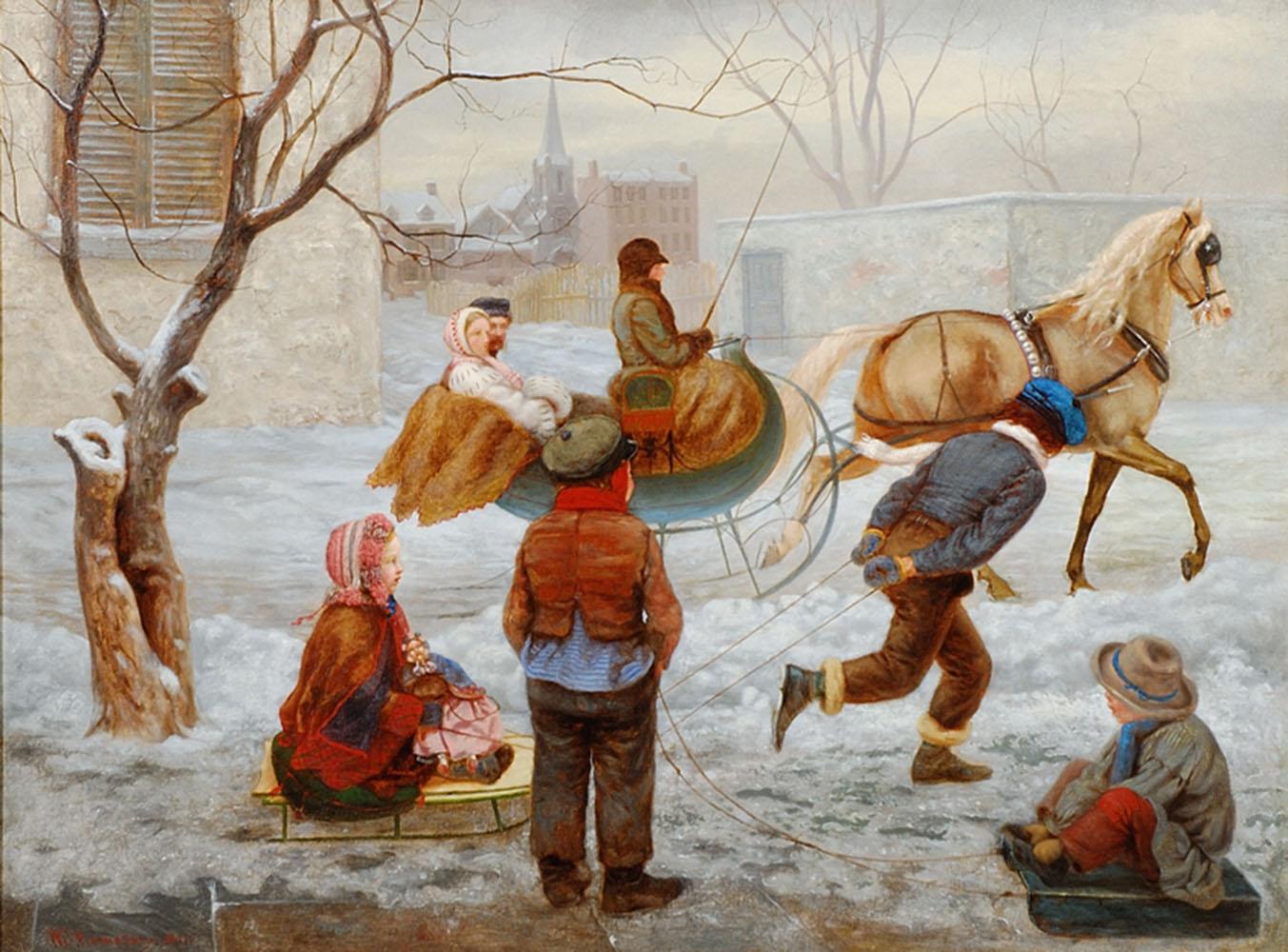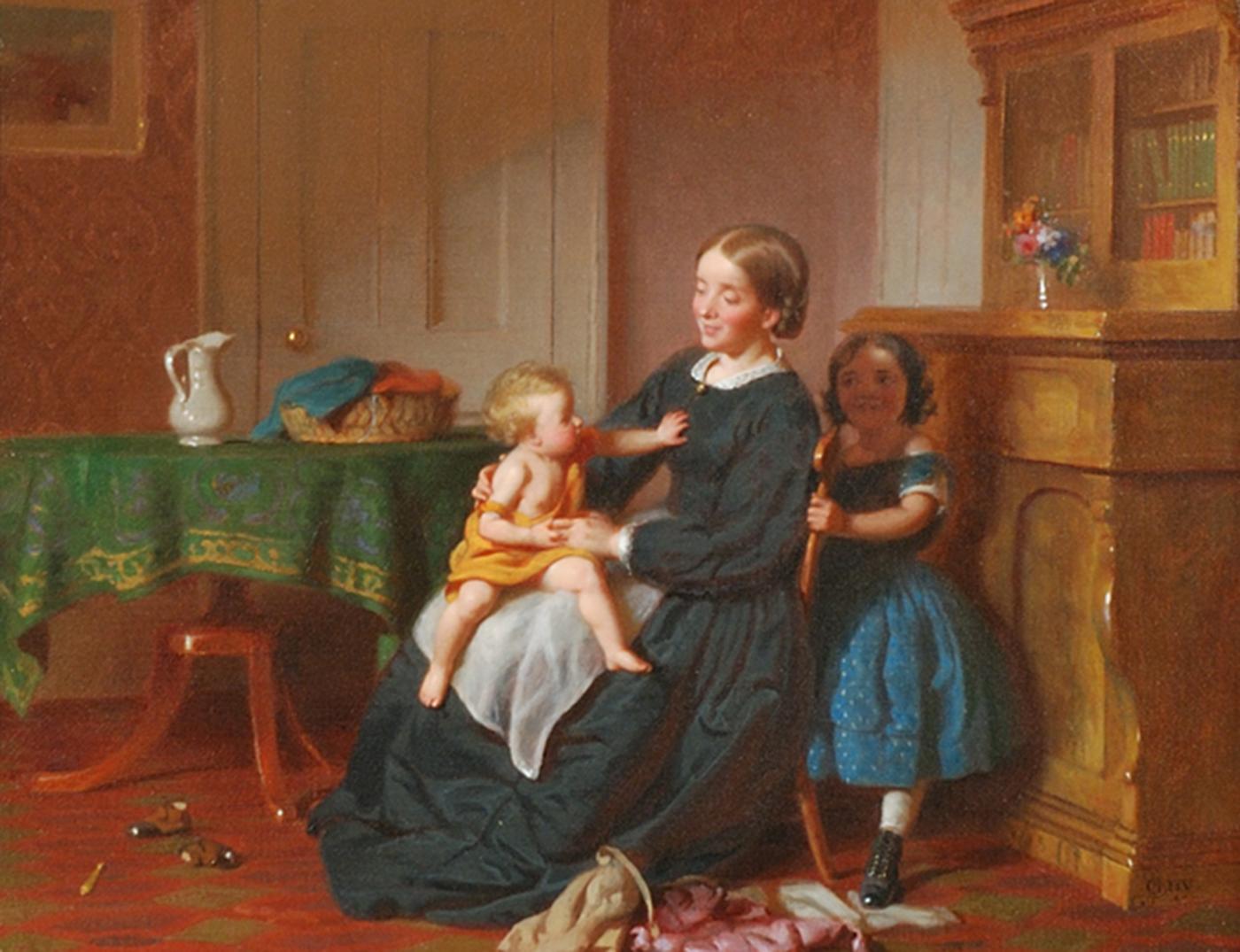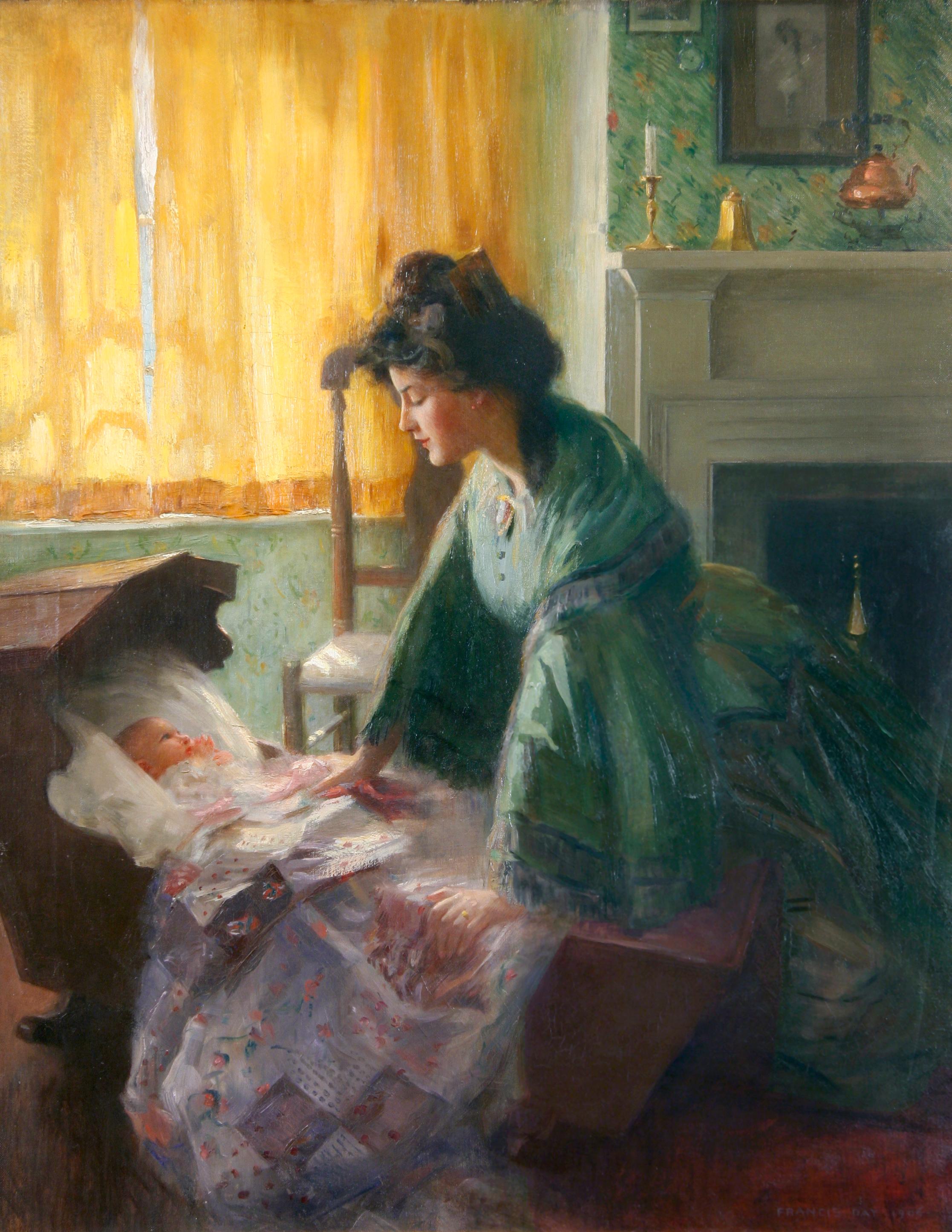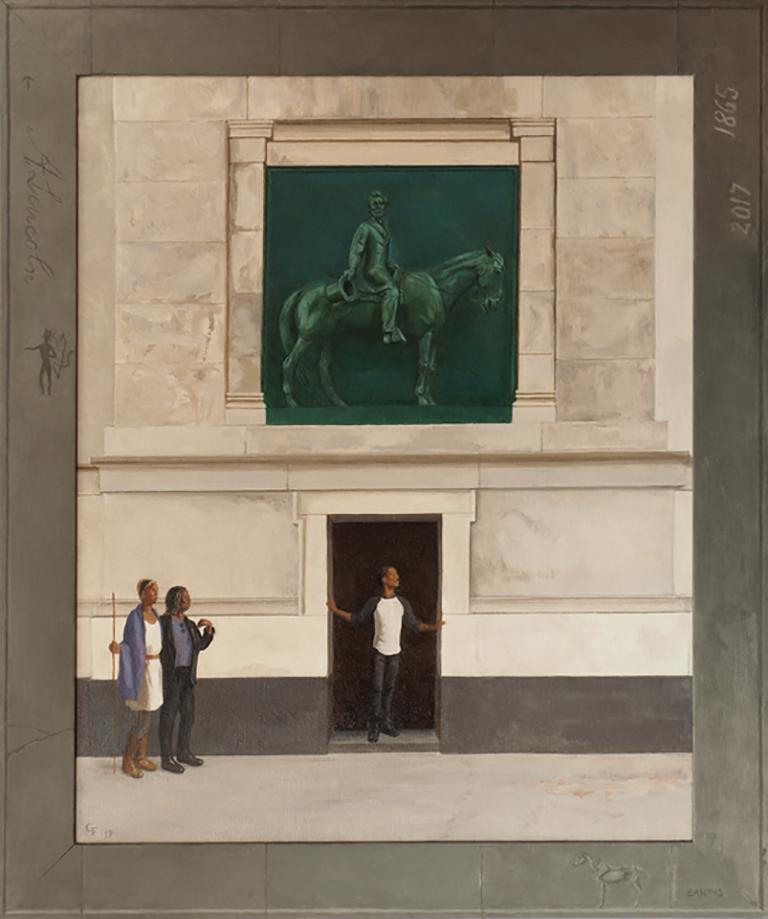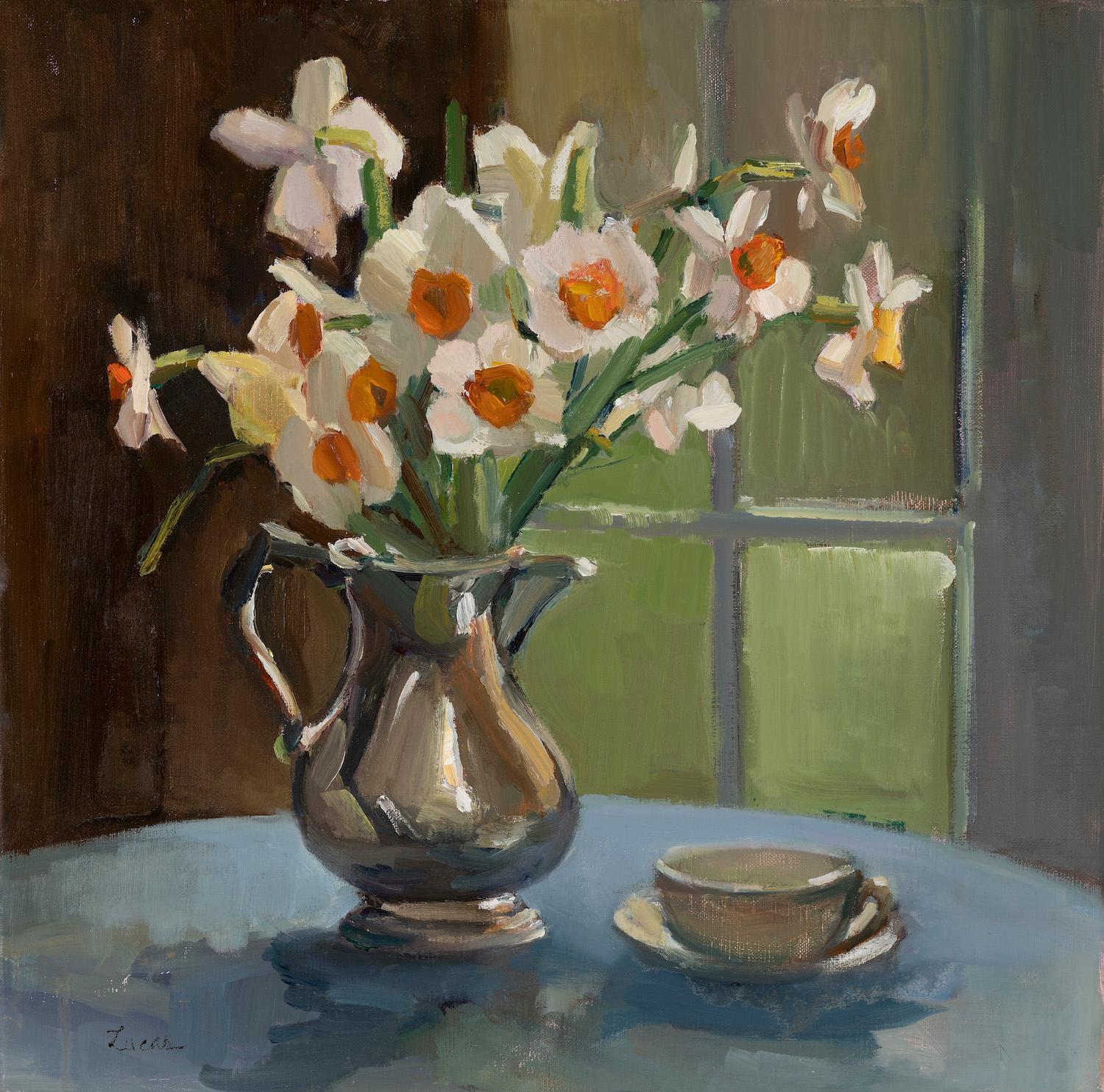Items Similar to 'Sketching Wisconsin' original oil painting, Signed
Want more images or videos?
Request additional images or videos from the seller
1 of 11
John Steuart Curry'Sketching Wisconsin' original oil painting, Signed 1946
1946
About the Item
John Steuart Curry
"Sketching Wisconsin," 1946
oil on canvas
31.13 x 28 inches, canvas
39.75 x 36.75 x 2.5 inches, frame
Signed and dated lower right
Overall excellent condition
Presented in a 24-karat gold leaf hand-carved wood frame
John Steuart Curry (1897-1946) was an American regionalist painter active during the Great Depression and into World War II. He was born in Kansas on his family’s farm but went on to study art in Chicago, Paris and New York as young man. In Paris, he was exposed to the work of masters such as Peter Paul Rubens, Eugène Delacroix and Jacques-Louis David. As he matured, his work showed the influence of these masters, especially in his compositional decisions. Like the two other Midwestern regionalist artists that are most often grouped with him, Grant Wood (American, 1891-1942) and Thomas Hart Benton (American, 1889-1975), Curry was interested in representational works containing distinctly American subject matter. This was contrary to the popular art at the time, which was moving closer and closer to abstraction and individual expression.
Sketching Wisconsin is an oil painting completed in 1946, the last year of John Steuart Curry’s life, during which time he was the artist-in-residence at the University of Wisconsin in Madison. The painting is significant in Curry’s body of work both as a very revealing self-portrait, and as a landscape that clearly and sensitively depicts the scenery of southern Wisconsin near Madison. It is also a portrait of the artist’s second wife, Kathleen Gould Curry, and is unique in that it contains a ‘picture within a picture,’ a compositional element that many early painting masters used to draw the eye of the viewer. This particular artwork adds a new twist to this theme: Curry’s wife is creating essentially the same painting the viewer is looking at when viewing Sketching Wisconsin.
The triangular composition of the figures in the foreground immediately brings focus to a younger Curry, whose head penetrates the horizon line and whose gaze looks out towards the viewer. The eye then moves down to Mrs. Curry, who, seated on a folding stool and with her hand raised to paint the canvas on the easel before her, anchors the triangular composition. The shape is repeated in the legs of the stool and the easel. Behind the two figures, stripes of furrowed fields fall away gently down the hillside to a farmstead and small lake below. Beyond the lake, patches of field and forest rise and fall into the distance, and eventually give way to blue hills.
Here, Curry has subverted the traditional artist’s self-portrait by portraying himself as a farmer first and an artist second. He rejects what he sees as an elitist art world of the East Coast and Europe. In this self-portrait he depicts himself without any pretense or the instruments of his profession and with a red tractor standing in the field behind him as if he was taking a break from the field work. Here, Curry’s wife symbolizes John Steuart Curry’s identity as an artist. Compared with a self-portrait of the artist completed a decade earlier, this work shows a marked departure from how the artist previously presented and viewed himself. In the earlier portrait, Curry depicted himself in the studio with brushes in hand, and with some of his more recognizable and successful canvases behind him. But in Sketching Wisconsin, Curry has taken himself out of the studio and into the field, indicating a shift in the artist’s self-conception.
Sketching Wisconsin’s rural subject also expresses Curry’s populist ideals, that art could be relevant to anyone. This followed the broad educational objectives of UW’s artist-in-residence program. Curry was appointed to his position at the University of Wisconsin in 1937 and was the first person to hold any such position in the country, the purpose of which was to serve as an educational resource to the people of the state. He embraced his role at the University with zeal and not only opened the doors of his campus studio in the School of Agriculture to the community, but also spent a great deal of time traveling around the state of Wisconsin to visit rural artists who could benefit from his expertise. It was during his ten years in the program that Curry was able to put into practice his belief that art should be meaningful to the rural populace. However, during this time he also struggled with public criticism, as the dominant forces of the art market were moving away from representation. Perhaps it was Curry’s desire for public acceptance during the latter part of his career that caused him to portray himself as an Everyman in Sketching Wisconsin.
Beyond its importance as a portrait of the artist, Sketching Wisconsin is also a detailed and sensitive landscape that shows us Curry’s deep personal connection to his environment. The landscape here can be compared to Wisconsin Landscape of 1938-39 (the Metropolitan Museum of Art), which presents a similar tableau of rolling hills with a patchwork of fields. Like Wisconsin Landscape, this is an incredibly detailed and expressive depiction of a place close to the artist’s heart. This expressive landscape is certainly the result of many hours spent sketching people, animals, weather conditions and topography of Wisconsin as Curry traveled around the state. The backdrop of undulating hills and the sweeping horizon, and the emotions evoked by it, are emphatically recognizable as the ‘driftless’ area of south-central Wisconsin. But while the Metropolitan’s Wisconsin Landscape conveys a sense of uncertainty or foreboding with its dramatic spring cloudscape and alternating bands of light and dark, Sketching Wisconsin has a warm and reflective mood. The colors of the foliage indicate that it is late summer and Curry seems to look out at the viewer approvingly, as if satisfied with the fertile ground surrounding him.
The landscape in Sketching Wisconsin is also revealing of what became one of Curry’s passions while artist-in-residence at UW’s School of Agriculture – soil conservation. When Curry was a child in Kansas, he saw his father almost lose his farm and its soil to the erosion of The Dust Bowl. Therefore, he was very enthusiastic about ideas from UW’s School of Agriculture on soil conservation methods being used on Wisconsin farms. In Sketching Wisconsin, we see evidence of crop rotation methods in the terraced stripes of fields leading down the hillside away from the Curry’s and in how they alternate between cultivated and fallow fields.
Overall, Sketching Wisconsin has a warm, reflective, and comfortably pastoral atmosphere, and the perceived shift in Curry’s self-image that is evident in the portrait is a positive one. After his rise to favor in the art world in the 1930’s, and then rejection from it due to the strong beliefs presented in his art, Curry is satisfied and proud to be farmer in this self-portrait. Curry suffered from high blood pressure and in his last years was especially crestfallen about criticism of his work in his home state of Kansas. The artist was only 48 when he died. In Sketching Wisconsin, it is almost as if Curry has decided to record the most important parts of his life with the knowledge that he did not have much time left. For that reason, this painting is perhaps more expressive and revealing of Curry’s life than any other from his last decade, if not his career.
This painting was exhibited at the Museum of Wisconsin Art, "John Steuart Curry: At Home in Wisconsin" in 2014
Essay by Monet C. Haskins and David J. Barnett
- Creator:John Steuart Curry (1897-1946, American)
- Creation Year:1946
- Dimensions:Height: 39.75 in (100.97 cm)Width: 36.75 in (93.35 cm)Depth: 2.5 in (6.35 cm)
- Medium:
- Movement & Style:
- Period:
- Framing:Frame IncludedFraming Options Available
- Condition:
- Gallery Location:Milwaukee, WI
- Reference Number:
John Steuart Curry
Born in Dunavant, Kansas on November 14, 1897, John Steuart Curry became the youngest member of the famed "Benton-Wood-Curry trio" of Regional Painters of the early 20th-century American Scene movement. He gained a national reputation for his rural Kansas scenes. The artist focused on people who were down-to-earth, plain spoken, and self-reliant, and who made a living through hard physical labor. Curry executed murals dealing with land settlement and racial justice, and his works reflecting these themes are in the Capitol Building in Kansas, the University of Wisconsin, the United States Department of the Interior, and the United States Department of Justice. The artist quit high school and attended the Kansas City Art Institute and School of Design. He transferred to the Art Institute of Chicago. Curry married Clara Derrick in 1923. He studied in Paris in 1927. He was not impressed by the modernist American painters, many of whom were adopting the 'isms' of French contemporary artists. Curry was determined to paint American subjects without European models and to celebrate patriotism, regional pride, and the common man. He settled in Westport, Connecticut. In 1928, he painted Baptism in Kansas. The painting was heralded nationally as work of a new American genre. It was exhibited at the Corcoran Gallery of Art biennial where it met critical acclaim. In 1931, Gertrude Vanderbilt Whitney bought it for her museum. Tornado over Kansas was unveiled in 1929 before the stock market crash and provided the city with the romance of man versus nature theme. In 1933, it received second prize at the Carnegie International Exhibit. In 1930, he had his first one-man exhibition at the Whitney Studio Club. His work of the 1930s contains themes of work, family, and land-- demonstrating the peace, struggle, and perseverance that Curry believed was the essence of American life. In 1934 he married Kathleen Shepard. The United States government selected him to paint murals for the Department of Justice and the Department of Interior. He was appointed Artist-in-Residence in the College of Agriculture at the University of Wisconsin in 1936. He was a member of the Art Students' League and won prizes including: Purchase prize, North West Print Maker, fifth annual Exhibition, 1933; second prize, Thirty-first International Exhibition, Carnegie Institute, 1933; gold medal, PAFA, 1941; prize, Artists for Victory Exhibition, the Metropolitan Museum of Art, 1941. Exhibitions include: “A Celebration of Rural America,” 2007, Danville Museum of Fine Arts and History; “Collective Images: the sketchbooks of John Steuart Curry, 2002, Worcester Art Museum; “Illusions of Eden: Visions of the American Heartland,” 2000, Columbus Museum of Art; “The American Century: Art and Culture 1900-2000,” Whitney Museum of American Art; and “John Steuart Curry: Inventing the Middle West,” 1998, M.H. de Young Memorial Museum. He died in Madison, Wisconsin in 1946.
About the Seller
4.9
Platinum Seller
These expertly vetted sellers are 1stDibs' most experienced sellers and are rated highest by our customers.
Established in 1966
1stDibs seller since 2017
392 sales on 1stDibs
Typical response time: 1 hour
- ShippingRetrieving quote...Ships From: Milwaukee, WI
- Return PolicyA return for this item may be initiated within 14 days of delivery.
More From This SellerView All
- "Pleasant Light, " an Oil on Canvas signed by Pamela PapasBy Pamela PapasLocated in Milwaukee, WI"Pleasant Light" is an original oil painting on canvas signed lower left by the artist Pamela Papas. It depicts a woman in a light-infused room tending to her plants. 29" x 15 1/4"...Category
21st Century and Contemporary Contemporary Figurative Paintings
MaterialsOil, Canvas
- "Two Country Village Women Outside Their House, " Oil on Canvas E. HyppoliteBy E. HyppoliteLocated in Milwaukee, WI"Two Country Village Women Outside Their House" is an original oil painting on canvas signed and dated in the lower right corner. It depicts two Haitian women working around their house. There is a variety of lush plants surrounding the house. 24 3/4" x 36" art 26 1/2" x 38 1/4" frame Framed to conservation standards in a floating frame with an brushed antique gold...Category
Early 2000s Figurative Paintings
MaterialsCanvas, Oil
- "Russian Village Scene, " Original Oil on Canvas signed by Olga VasilevlkayBy Olga VasilevlkayLocated in Milwaukee, WI"Russian Village Scene" is an original oil painting on canvas by Olga Vasilevlkay. The artist signed the painting in the lower right. This piece depict...Category
1980s Figurative Paintings
MaterialsOil, Canvas
- "The Saint of the Flaming City, " Oil on Canvas signed by Raymond BreininBy Raymond BreininLocated in Milwaukee, WI"The Saint of the Flaming City" is an original oil painting on canvas by Raymond Breinin. It depicts a group of figures looking over an abstracted and green city as the colors of fire rage through the sky. The artist signed and dated the piece in the lower right. This painting was lent by the David Barnett Gallery to the Art Institute of Chicago for their 52nd Annual Exhibition. 30" x 40" art 39 3/4" x 49 3/4" frame Raymond Breinin, Russian/American painter & designer (1910-2000), was born in Vitebsk, Russia, where he commenced his art studies with Uri Pen (who was also the first teacher of Marc Chagall) and later attended the Vitebsk Academy of Art where Malevitch was the director. He came to the United States with his family in 1922. When he came to America he attended classes at the Art Institute of Chicago and the Chicago Academy of Fine Arts. A painter of murals for the WPA, he was invited to join the Downtown Gallery in New York City, one of the foremost galleries at the time, where he exhibited in one man shows and group shows over a period of 18 years. The winner of numerous major prizes at the Chicago Art Institute and other museums, he also won the $1000 purchase prize at the Metropolitan Museum of Art's "Artists for Victory" exhibition. He designed the sets and costumes for Anthony Tudor's ballet, "Undertow" produced by the American Ballet Theater. He executed commissions for "Life", "Fortune" and "Redbook" magazines, for the Capehart Corporation, Eli Lilly...Category
1940s Expressionist Landscape Paintings
MaterialsOil, Canvas
- Early 20th century oil painting figures temple horses foliage trees womanLocated in Milwaukee, WIThis painting is by an unknown Indonesian painter. The artist signed the painting "M. Kelistm" and is from Ubud, Bali. It features a large number of figures carrying a large sculptur...Category
1920s Figurative Paintings
MaterialsCanvas, Oil
- "Tres Madres, " Original Oil Painting on Canvas signed by Ernesto GutierrezBy Ernesto Gutierrez (b.1941)Located in Milwaukee, WI"Tres Madres" is an original oil painting on canvas by Ernesto Gutierrez. The artist signed the piece lower right. It depicts three mothers in Peruvian dress carrying small children ...Category
Early 2000s Contemporary Figurative Paintings
MaterialsOil, Canvas
You May Also Like
- The RaceBy William John HennessyLocated in New York, NYWilliam John Hennessy was born in Ireland. He came to America in 1849 with his mother and brother a year after his father had fled their homeland after taking part in the unsuccessful Young Ireland Party uprising. The Hennessys settled in New York, and when young William came of age, he decided upon a career as an artist. At the age of fifteen, he enrolled at the National Academy of Design, where he learned to draw from the antique, and the following year he was granted admission to the Academy’s life-drawing class. Hennessy first exhibited at the National Academy in 1857, starting a continuous run of appearances in their annuals that lasted until 1870, when he expatriated himself to Europe. During his time in America, Hennessy was principally known as a genre painter and prolific illustrator for such publications as Harper’s Weekly and a number of books, including illustrated works of William Cullen Bryant...Category
19th Century American Realist Figurative Paintings
MaterialsCanvas, Oil
- Peek-a-BooBy Seymour Joseph GuyLocated in New York, NYIn the latter half of the nineteenth century and into the first decade of the twentieth, New York City art aficionados could count on finding recent work of Seymour Joseph Guy hanging on the walls of the city’s major galleries. Primarily a genre artist, but also a portraitist, between 1859 and 1908 Guy showed more than seventy works at the National Academy of Design. From 1871 to 1903 he contributed over seventy times to exhibitions at the Century Club. From 1864 to 1887, he sent about forty pictures to the Brooklyn Art Association. A good number of these works were already privately owned; they served as advertisements for other pictures that were available for sale. Some pictures were shown multiple times in the same or different venues. Guy was as easy to find as his canvases were omnipresent. Though he lived at first in Brooklyn with his family and then in New Jersey, from 1863 to his death in 1910 he maintained a studio at the Artist’s Studio Building at 55 West 10th Street, a location that was, for much of that period, the center of the New York City art world. Guy’s path to a successful career as an artist was by no means smooth or even likely. Born in Greenwich, England, he was orphaned at the age of nine. His early interest in art was discouraged by his legal guardian, who wanted a more settled trade for the young man. Only after the guardian also died was Guy free to pursue his intention of becoming an artist. The details of Guy’s early training in art are unclear. His first teacher is believed to have been Thomas Buttersworth...Category
19th Century American Realist Figurative Paintings
MaterialsCanvas, Oil
- Light of LoveLocated in Washington, DCExhibited: National Academy of Design, New York, 1906 (as no. 101) Art Institute of Chicago, 1908 (as no. 74)Category
Early 1900s American Realist Figurative Paintings
MaterialsCanvas, Oil
- Antique American Oil Painting Portrait Young Woman Necklace Period Frame RareLocated in Buffalo, NYA beautiful and rare antique American portrait of a young woman in a stunning period frame, likely original to the piece. Unsigned but beaut...Category
1890s American Realist Portrait Paintings
MaterialsOil, Canvas
- America 2017, New York, urban architecture, subtle colorBy Gregory FruxLocated in Brooklyn, NYOil on canvas Dr. Rowland S. Russell PhD. writes about his experience directly witnessing Greg's practice as a “plein air” artist: Whether he’s portraying quiet scenes from Brooklyn...Category
2010s American Realist Landscape Paintings
MaterialsOil, Canvas
- Spring RainBy Maryann LucasLocated in Sag Harbor, NYAn oil painting of daffodils in a silver vessell. Situated upon a table, before a window. Maryann Lucas lives and works in Sag Harbor. She is primarily self-taught but has also rec...Category
2010s American Realist Still-life Paintings
MaterialsOil, Canvas
Recently Viewed
View AllMore Ways To Browse
Sketch Vintage
Vintage Body Painting
Hand Sketches
Sketches Of Hands
Art Vintage Sketches
Paris Sketch
Small Vintage Oil Paintings
Paris Sketch Art
Sketch Art Paris
Oil Paintings Of The American South
Small Sketches
Paris Original Oil Canvas Painting
Vintage Oil Painting Gold Frame
1891 Painting
John Golding Painting
Small Paris Oil Painting
Traditional Original Oil Paintings
Vintage Hours Sign
